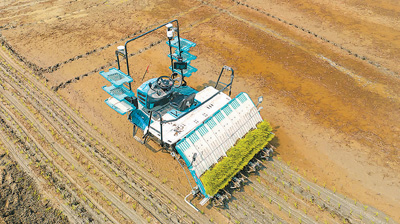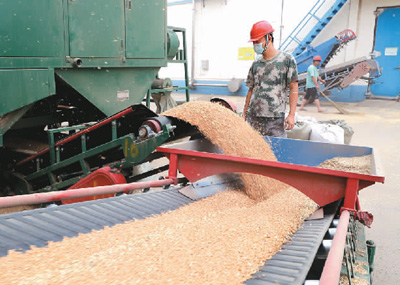Tech makes summer harvesting, sowing, management more efficient
China has adopted advanced technologies to facilitate summer harvesting, sowing and field management.
So far, the mechanization in the harvesting of staple crops has been realized in the country, with the mechanization rate of the harvesting of wheat, rice and corn exceeding 97 percent, 94 percent, and 78 percent, respectively.

An unmanned rice transplanter works in a field in Diaoyu township, Xinghua city, east China's Jiangsu Province. (Photo/Zhou Shegen)
The contribution rate of agricultural sci-tech progress in China has increased from 54.5 percent in 2012 to the current more than 62 percent.
In Beijie village, Zaosheng township, Qingyang city of northwest China's Gansu Province, combine harvesters shuttled across wheat fields.
"It used to take me at least three hours to manually harvest wheat in one mu (0.067 hectares) of farmland. Now I can harvest 10 mu of wheat in one hour with the use of a combine harvester," said Zhu Pingfang, a local major grain grower.
"I planted 160 mu of wheat this year and harvested all my wheat in half a day using combine harvesters, which saved time and labor," Zhu added.
Gansu planned to use 14,000 such machines to harvest 11.06 million mu of wheat, said Liu Wenwu, director of the agricultural mechanization management division of the province's department of agriculture and rural affairs. According to Liu, over 3.4 million mu of winter wheat in Qingyang city and Pingliang city is expected to be fully harvested in 10-plus days.
At an unmanned farm in Laodian township, Huaxian county, central China's Henan Province, a self-driving harvester and a grain truck, both equipped with the BeiDou Navigation Satellite System (BDS), worked in collaboration in a field, after farmer Li Baogen programmed them.

A crop protection drone sprays pesticides in a paddy field in Huangxi village, Liugongmiao township, Zhangshu city, east China's Jiangxi Province. (People's Daily/Zhou Liang)
"In less than two days, 1,200 mu of wheat was harvested," Li said. Thanks to the BDS, the harvesters can automatically reap wheat after setting parameters for them on mobile phones and achieve continuous operations at night, while farmers can remotely follow the harvesting process, Li added.
Li noted that the unmanned farm has also applied new technologies such as 5G and realized fully automated plowing, planting, management, and harvesting.
Regions across China have enhanced post-production grain services and technological capacity for food loss reduction.
In Dayang township, Qiaocheng district, Bozhou city, east China's Anhui Province, harvested wheat was sent to a drying tower that stands over 40 meters above the ground. Equipped with advanced dust removal technology and large fans, the drying tower helps reduce the loss rate of harvested wheat by about 6 percent compared with the traditional way of drying wheat under the sun.
In recent years, the National Food and Strategic Reserves Administration has built over 5,500 professional post-production grain service centers to provide timely cleaning and drying services for farmers. Regions across China have popularized the use of 10 million sets of equipment for grain storage.
Qihe county, a major grain producer in Dezhou city, east China's Shandong Province, has built 16 grain service centers equipped with 38 smart granaries, which are each able to store more than 5,000 tonnes of grain, in its 15 towns and townships since the beginning of 2022. Thanks to the application of the Internet of Things, grain loss during storage at these smart granaries is less than 0.9 percent, which means a loss reduction of 7,000 tonnes of grain every year.

A worker uses machines to convey wheat in Huanghelu neighborhood, Dongying district, Dongying city, east China's Shandong Province. (People's Daily/Liu Zhifeng)
At a planting base in Fangcheng township, Lanshan district, Linyi city of Shandong, operator Zhang Fuqian drove a no-till precision seeder with fertilizing apparatus to sow corn seeds in a 400-mu field.
"The precision seeder can sow corn seeds in 8 to 10 mu of farmland per hour, and the seedling emergence rate exceeds 95 percent," Zhang said.
According to an official at the department of agriculture and rural affairs of Shandong, the province has put into use high-performance agricultural machines such as precision seeders and BDS-based seeders to make summer sowing more precise and efficient.
In Pidu district, Chengdu city of southwest China's Sichuan Province, farmer Zhao Dongming used a crop protection drone to spray pesticides.
In Zhao's paddy field, there is also a device equipped with a smart system that identifies pests. The device lights up at night to attract pests, and then takes photos of the bugs and uploads them to a cloud platform which gives recognition results in seconds. The system analyzes the identification results and makes predictions. Once the results hit the alarm value, the system will notify relevant management departments and farmers.
"I sprayed pesticides whenever there were bugs in the field in the past. Now, with the system, I know exactly when, how much and which pesticides shall be used, which not only reduces the use of pesticides, but also ensures food safety," said Zhao.
Photos
Related Stories
- Digital technicians help farmers work smart
- China's bumper harvest brings confidence amid global inflation
- China unveils first modern protected agriculture development plan
- Farmers harness science, technology to improve harvest
- Chinese scientists decipher genome secrets of foxtail millet
- Unmanned plowing machine in rural China
Copyright © 2023 People's Daily Online. All Rights Reserved.









